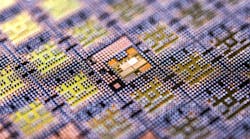Texas Instruments is lowering the bar for companies to add radar capabilities to warehouse robots that automatically grab inventory or systems that monitor the number of building occupants. The analog semiconductor giant is expanding its line of radar chips into millimeter wave bands not subject to the same tight regulations and bandwidth limitations as its existing products.
The company said that the chips operate over the 60 GHz band, which has significantly more bandwidth than the 24 GHz band used in shorter range radar, without surrendering the main advantages of millimeter waves. Tapping into higher bandwidths results in higher radar resolution and range. The chips can more accurately measure the distance to objects while shrinking antennas and other high-frequency circuits.
Companies have had to pay less and less for millimeter wave radar chips in recent years. That has resulted in them being installed in everything from robots used on assembly lines to manufacture cars and other products to smartwatches that interpret hand gestures to replace touchscreens or voice commands. Texas Instruments is fighting over the radar market with Robert Bosch, Infineon and NXP Semiconductors.
Last year, the Dallas, Texas-based company introduced a line of millimeter wave radar chips that that measures the distance to objects within the width of a human hair and could be used in high resolution systems. The chips operates over frequencies ranging from the 76 to 81 GHz bands, which were opened in the United States for automotive uses. The parts entered volume production earlier this year.
Texas Instruments said that "thousands of customers" were using them in development. But the United States and Europe limit the use of these millimeter wave bands in factories, buildings and infrastructure, said Robert Ferguson, business manager for millimeter wave sensors at Texas Instruments. The company designed its latest chips for the 60 GHz band so that it could serve the widest range of applications.
“There are several commonalities between automotive and industrial applications,” Ferguson told Electronic Design. He added that the range, resolution and accuracy of the radar are critical requirements for both. “The main difference in the industrial market is the wide range of applications and their diverse set of challenges,” Ferguson said. “Our solutions bring a level of accuracy and performance which we believe is new to these markets.”
The company’s latest chips take advantage of the 60 GHz band's ultrawide bandwidth. The resulting range resolution shorter than the wingspan of a bumblebee. Texas Instruments said that radar chips operating over the 24 GHz band are more than 15 times less accurate. In 2022, the U.S. and Europe are planning to prohibit the use of ultrawide bandwidth at the 24 GHz band, a move seen as severely impeding its usefulness for industrial radar.
Texas Instruments has integrated a microcontroller and digital signal processor into every chip instead of offering sensing and processing separately. That allows the chips to output processed data—and can handle simple artificial intelligence tasks like object classification—instead of raw information. The new chips are also designed to accurately sense through a range of materials, including dry wall, plastic, clothing and glass.
The integrated processing capabilities not only reduce false positives but also enable real-time decision-making. That can eliminate the need for customers to install separate microcontrollers. The chips are based on complementary metal-oxide semiconductor (CMOS) technology. Texas Instruments said on Wednesday that its latest radar chips will enter pre-production before the end of the month.
Texas Instruments is also offering to integrate the antenna into the same package as the radar sensor, potentially reduce the size of the system 75 percent, lowering overall costs and solving manufacturing challenges. “As industrial customers continue to adopt this technology, it is clear that not all of them have the expertise to design and manufacture antennas,” Ferguson told Electronic Design.

